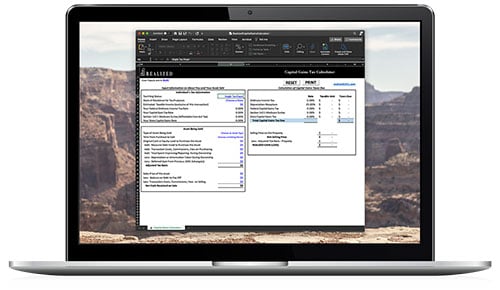
Capital gains are the result of profit generated from the sale of an asset. Capital gains apply to both equity investments and real estate. When the value of a property rises above its cost basis or adjusted tax basis, the investment experiences a gain. The opposite happens when the value of a property falls below its cost basis or adjusted tax basis. This is called a capital loss.
Taxes come into play when a property is sold at a gain. The sale of property at a profit is called a realized gain. Let’s look at realized and unrealized gains in more detail.
Realized vs. Unrealized Gains
As long as a property is held, any profit cannot be captured. Such a gain is referred to as an unrealized gain or “paper gain” since it can’t be declared as profit on an investor’s books. Once the property is sold, the gain becomes realized. At that point, a taxable event is triggered, and taxes on the gain must be paid.
A realized loss occurs when a property is sold below its adjusted tax basis. Since the investor did not make a profit on the sale, no taxes are due. Capital losses may be used to offset similar types of capital gains, and if capital losses are more than capital gains during the year, the investor has a net capital loss. Up to $3,000 of net capital loss can be declared on the investor’s tax return to offset other types of income — including salary, for example. Any amount exceeding $3,000 can be carried over as a loss into the next year, helping to offset future taxes from ordinary income.
Tax Consequences
Capital gains taxes are handled differently for stock investments than they are for real estate. For stocks, gains are based on the cost basis. For example, a stock bought at $100 and sold at $125 has a $100 cost basis and gain of $25. As a more complex example, if 100 shares of Stock A are bought at $95 and two months later another 100 shares are bought at $105, the cost basis is $100. If the stock is sold for $125, just as in the previous example, the gain is $25 per 100 shares.
A real estate basis is the purchase price of a property with expenses, such as commissions, factored in. The adjusted basis is used when calculating taxable gains. The adjusted basis includes the cost in acquiring the home plus the cost of any capital improvements made by the owner, less casualty loss amounts, and other decreases such as depreciation. Taxable gains are based on the sale price minus the adjusted basis.
Short-Term vs. Long-Term Capital Gains
Short-term investments are those held for one year or less. Long-term investments are held for more than a year. Gains generated on short-term investments are taxed at the ordinary income tax rate.
The government rewards long-term investments with a lower tax rate. Long-term taxable gains are divided into three brackets based on income (2019, single filer):
- 0% — $0 to $39,375
- 15% — $39,376 to $434,550
- 20% — $434,551 or more
State Taxes
Short-term capital gains are handled the same way by states as they are by the federal government — they’re taxed as ordinary income. For long-term gains, state tax rates differ from that of the federal government’s 0%, 15%, and 20% rates. Generally, state long-term capital gains rates are lower than federal rates. State long-term tax rates are the same as the state’s income tax rates. Here are a few examples of income tax rates by state:
- Arizona — 3.4%
- California — 13.3%
- Nevada — 0%
- New Jersey — 6.625%
- South Dakota — 0%
For those living in California and making at least $1 million (highest tax bracket) as a single filer, they pay the 20% federal rate plus California’s 13.3% rate for a total long-term capital gains rate of 33.3%, excluding the 3.8% Medicare surtax.
Unique Tax Benefit For Deferring Capital Gains
Real estate offers a special benefit to deferring capital gains. It’s called a 1031 exchange or 1031 tax-deferred exchange. The name comes from the IRS section 1031 code. A 1031 exchange takes the proceeds from the sale of one investment property (not a primary residence) and uses them in the purchase of another investment property within 180 days of the sale.
A 1031 exchange involves a few steps:
- Sell property.
- Qualified intermediary receives proceeds of sale.
- Within 45 days of sale, identify replacement property of equal or greater value.
- Investor must close on identified properties within 180 days.
- Funds are then sent to the seller of the replacement property.
Deferring Capital Gains Using Qualified Opportunity Zones
Qualified Opportunity Zones (QOZs) are designated areas that offer tax benefits to investors. One of these benefits is the deferral of capital gains. When an investment is made in a QOZ, the investor can defer capital gains from the sale of the investment until 2026.
This strategy can significantly benefit investors, as it allows them to reinvest their gains without incurring a tax liability. Certain requirements must be met for an investment to qualify for this advantage, but QOZs offer a unique opportunity to defer capital gains and invest in disadvantaged communities that can benefit from housing investments.
Capital gains signify that profit was generated from the sale of an asset. Capital gains also trigger a taxable event. Knowing the various options available to help offset taxable gains can result in a more favorable transaction outcome.
Please note: this information is based on data gathered from what we believe are reliable sources. It is not guaranteed as to accuracy, does not purport to be complete, and is not intended to be used as a primary basis for investment decisions. Realized does not offer legal or tax advice. The application and impact of tax laws can vary widely based on the specific facts involved. As such, this information should not be used as a substitute for consultation with professional accounting, tax, legal or other competent advisors. Before making any decision or taking any action, you should consult with a qualified professional. Investors in QOFs will need to hold their investments for certain time periods in order to receive the full QOZ Program tax benefits. A failure to do so may result in the potential tax benefits to the investor being reduced or eliminated. If a fund fails to meet any of the qualification requirements to be considered a QOF, the anticipated QOZ Program tax benefits may be reduced or eliminated. Furthermore, a fund may fail to qualify as a QOF for non-tax reasons beyond its control, such as financing issues, zoning issues, disputes with co-investors, etc. Distributions to investors in a QOF may result in a taxable gain to such investors.The tax treatment of distributions to holders of interests in a QOF are uncertain, including whether distributions impact the aforementioned QOZ Program tax benefits. A QOF must make investments in Qualified Opportunity Zones, which carries the inherent risk associated with investing in economically depressed areas.


